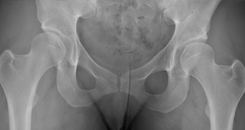A 22-year-old female college student was referred to Duke for treatment of bilateral hip dysplasia and a labral tear after arthroscopy performed in another state to repair the tear failed to alleviate her pain (Figure 1). 
An avid competitive ice dancer, the woman had stopped performing because of the pain. Although she was considering other activities that wouldn’t require the extreme range of motion needed for ice dancing, the patient was highly motivated to explore all treatment options.
Duke orthopaedic surgeon and hip preservation specialist Steven Olson, MD, consulted with the patient. “She had already tried nonoperative care and arthroscopy to repair the labral tear,” he says. “Those treatments were helpful for a short time, but her pain recurred after the tear was repaired without treating the underlying hip dysplasia.”
Another option was for the patient to modify or stop the activities she wanted to do and wait until she was ready for a total hip replacement, but Olson believed that she was too young for that to be the best course of action.
Question: What procedure did Olson perform to alleviate the woman’s pain, avoid or delay the onset of arthritis, and preserve her native joints?
Answer: Olson performed periacetabular osteotomies (PAO) on each hip, one year apart. PAO is a state-of-the-art technique to re-orient the position of the hip socket to treat hip dysplasia.
During the procedures, Olson cut the bone of the pelvis to free the hip socket, rotated each socket into a better position, then secured the socket in its new position with screws (Figure 2). Over time, the bones grow together and the hip sockets remain in the corrected position. Although the screws typically remain inside the body permanently, the patient’s slender frame made the screw heads more prominent than usual, so Olson removed them on each side one year postoperatively. 
“This patient had significant dysplasia,” says Olson. “The femoral head didn’t cover the sockets well at all, so we had to make sure we covered them well and also repair the labral tear. This was definitely a challenging operation.”
Olson notes that one of the challenges in treating young, active patients who have hip dysplasia is setting appropriate expectations. This is because before surgery the hip socket is shallow, which can allow extreme range of motion. However, this excess motion also predisposes these patients to labral tears as the labrum grows larger to compensate for the lack of bone in the socket.
As a result of the surgery, patients will lose some degree of hip motion, making their motion what many people would consider to be normal. This patient already knew she was moving on from ice dancing to other activities that wouldn’t require extreme motion, so PAO was the preferred treatment for her, he says.
“We all have occasional aches and pains,” says Olson, “but the labrum is an early warning—when it tears it starts to hurt people in a significant way. These patients are at risk for changes in their joints that lead to arthritis and a lifetime of pain.”
The patient pursued a career as a chef, and, although she’s no longer ice dancing, her hip dysplasia is corrected and is no longer causing pain that could lead to osteoarthritis. “We got to her early in the course of the disease, and she’s doing very well now,” says Olson.
Because PAO is a technically challenging procedure and requires a high level of expertise, Olson recommends that patients be referred to centers with experienced specialists. Duke is one of only a few centers on the East Coast that regularly performs PAO surgery. Olson and his colleague Brian Lewis, MD, an orthopaedic surgeon and hip specialist, perform 50 to 60 of the procedures each year.